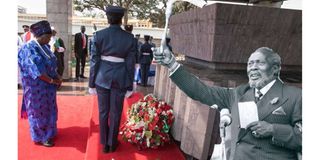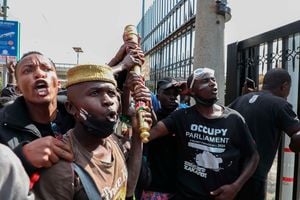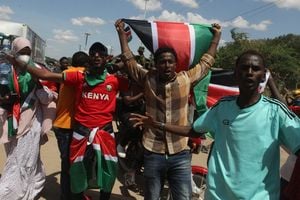The fading legacy of Jomo Kenyatta, 44 years after his death

Former First Lady Mama Ngina Kenyatta pays her respects at the Mausoleum of Kenya's founding father Mzee Jomo Kenyatta, at Parliament Buildings in Nairobi
As the nation today marks 44 years since the death of Jomo Kenyatta, it will be the second time that there will be no public commemoration as had been the tradition. This has raised fears among Jomo’s adherents that his legacy could be heading into oblivion.
Through President Uhuru Kenyatta, the family said two years ago that going forward, the commemoration of the death of Kenya’s first president would be a private affair. “The family of Jomo Kenyatta has agreed that this is going to be the last celebration of Mzee in this manner (publicly)…”

Military personnel during the 35th anniversary of the late Mzee Jomo Kenyatta at his mausoleum at Parliament Buildings in Nairobi, on August 22, 2013.
With Kenya having lost all its past presidents – Daniel arap Moi in February 2020 and Mwai Kibaki in April 2022 – the complexity of having the president lead the nation in commemorating only one of its past presidents – and not the others, would have become a poser.
As President Kenyatta prepares to leave office, today would have been his last chance to lay a wreath at Jomo’s grave at the precincts of Parliament where he was laid to rest.
Zambia seems to have overcome this problem by having elaborate tombs at Embassy Park in Lusaka, where its former presidents are buried. In 2015, the Cabinet had passed a resolution that “all departed republican presidents” should be buried in “dignified manner and in properly designated places… with supporting facilities matching such burial sites, for visitors to learn about their individual and collective contributions to the nation.”
When Kenneth Kaunda died in July last year, the High Court dismissed a petition by one of his sons to have him buried at his rural farm next to his late wife. While Kenya’s new museum along Lang’ata Road has sections with mementoes on former presidents – the question on how to memorialise their contributions has been left open.

President Yoweri Museveni of Uganda pays his respects after laying a wreath at the mausoleum of Mzee Jomo Kenyatta on March 29, 2019.
Past Kenyatta memorial ceremonies included a church service attended by the President, the Kenyatta family led by First Lady Mama Ngina Kenyatta, and senior government officials. The laying of the wreath ceremony was conducted by the Kenya Defence Forces, including a military parade. In the last 44 years, the military has always guarded the mausoleum which, ironically, was never opened to the public.
While similar mausoleums in Africa have been turned into national memorial sites of, it has never been explained why Kenyatta was kept away, in death, from the people he led.
Pundits argue that the private commemoration not only removes Jomo’s memory further from the public glare but threatens to erase him from Kenya’s living memory. Talk within the Kenyatta family was that the grave should be relocated to Ichaweri village – the same way Moi and Kibaki were buried in their rural farms.
For years, some activist had been pushing for the establishment of a “Heroes Acre”, which was to become the burial ground of national heroes and former presidents. The Kenya Heroes Act of 2014 did not address the issue and instead left it to the Heroes Council to establish “Heroes’ Squares in such places it may deem appropriate” and maintain a register of heroes there.
The section states: “Notwithstanding the place of burial of a hero, the Council may whenever it considers it necessary or appropriate, build and maintain symbolic tombs, monuments and statues in honour of such hero and may preserve plaques, material culture, photographs, memoirs and histories of the hero at the Heroes’ Square.” It left the matter of Heroes Acre unattended. More so, it did not address the question on who maintains mausoleums in public spaces – such as that of Jomo Kenyatta.

Former First Lady Mama Ngina Kenyatta (centre) lays a wreath at the late Mzee Jomo Kenyatta Mausoleum at Parliament Buildings on August 22, 2014.
Kenyatta’s death in 1978 came at a time when he was one of the most respected Pan-Africanists – a member of a generation that had been involved in the struggle for independence and setting up of post-colonial states, albeit with all the challenges that came with Cold War machinations.
How this generation – which included, among others, Julius Nyerere, Kamuzu Banda, Kenneth Kaunda, Kwame Nkrumah, Felix Houphouet-Boigny and Ahmed Sekou Toure – handled their states and played both local and international politics determined their separate legacies.
More so, they have been ostracised for setting up single-party institutions or for failing to end poverty levels for either leaning towards capitalism or socialism.

President Uhuru Kenyatta lays a wreath at the mausoleum of Kenya's founding president Mzee Jomo Kenyatta on August 22, 2014.
In Kenya, critics of Jomo Kenyatta point to the post-independent land settlement chaos, the creation of a super-elite block and silencing of the opposition as some of his failures. They, however, all agree that Jomo was a benevolent leader – surrounded by a mass of needy population and controlled by political cartels as he aged.
But his contribution to Kenya’s fight for independence has, however, never been lost – even to his critics. During the just-concluded general elections’ campaigns, Jomo’s name was invoked, albeit negatively, as the battle for votes raged between President-elect William Ruto and former Prime Minister Raila Odinga.
The Dr Ruto wing capitalised on Jomo’s family excesses, their wealth and historical grievances to mobilise votes in Mt Kenya and to cast Mr Odinga as a member of the ruling dynasty. “I am a son of a Mau Mau,” the Deputy President-elect Rigathi Gachagua would always tell jubilant supporters.
Whether the incoming government will get a formula to commemorate past presidents will be something to watch. But with Kenyatta’s death marked in silence – a chance of national remembrance fades in oblivion.
[email protected] @johnkamau1





